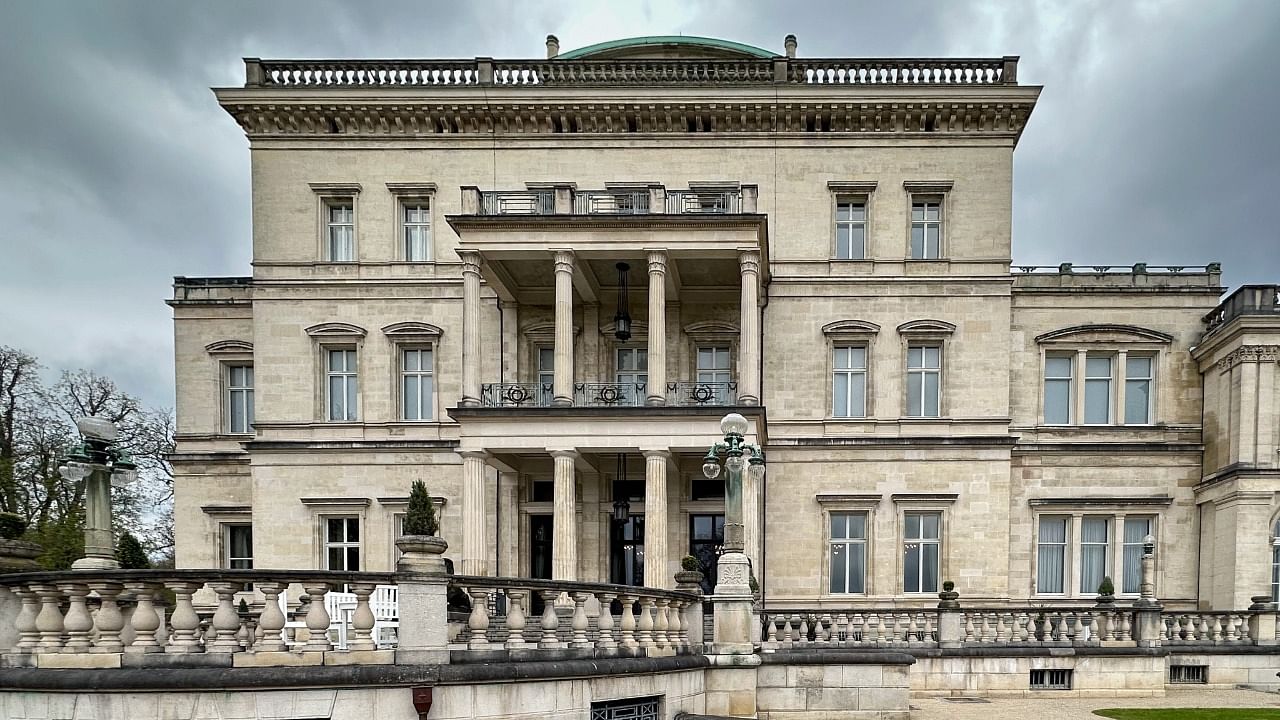
Krupp's family home.
Photo by author
Visitors strolling through Essen can be forgiven for not immediately realising that it’s one of Germany’s most culturally progressive cities. This former industrial centre has gone through multiple avatars. Around 850 AD, the city was founded as a monastery for Saxon nobility. By the 16th century, it was a coal mining hub. Consequently, it grew to prominence owing to the part played by the Krupp family, who over several generations set up a booming steel manufacturing plant here.
The spirit of Essen comes from the fact that the city has persistently reinvented itself, making the change from an industrial powerhouse to a much-lauded centre of culture. Smack in the city centre is the Museum Folkwang, home to a feast of 20th-century paintings, showcasing a vast body of art from Renoir to Richter. Not far from the Museum Folkwang is the medieval Dom or Essen Cathedral. Inside are relics and treasures from the Ottonian empire. Especially worthy of note is the statue of the Golden Madonna, whose piercing eyes linger in memory. A smart city is frequently one that having grown through a variety of changes, makes those changes visible. Former industrial spaces, rather than being demolished, have taken on new avatars as cinemas, concert halls and museums. Now a UNESCO World Heritage Site is the Bauhaus-style Zollverein coal mine, which reinvented itself as a culture hub. Inside the dark ambience of the converted coal washing plant, with its stone walls, steep steel stairs and aluminium ducts, is the Ruhr Museum. Another key space inside this former mine is the Red Dot Design Museum. Architect Norman Foster skilfully adapted the space, from a cathedral of the industrial age, with its towering chimneys and vast halls, into a functional display site for a range of award-winning design objects, without fundamentally altering the character of the space.
Another good way to experience the city is to sign up for Essen 1887 — a mixed reality time travel programme. I walk through the city centre donning mixed-reality glasses and bluetooth headphones. Unlike virtual technology glasses, with the latest mixed-reality technology — namely Nreal light glasses, one maintains an awareness of one’s surroundings, while experiencing virtual reality. Digital markers are set at various locations in the city centre to which the glasses react. Houses, carriages, animals, buildings and people appear in period costumes. The people appear as volumetric holograms, which means that you can view them from all angles, as they speak to you. The fact that I’m in the middle of the city without losing my bearings or sight of the surroundings, makes this experience unique. During this virtual walking tour, I’m once more reminded of the fact that it was the industrial magnate Alfred Krupp’s steel factory that morphed the fortunes of the city of Essen. To learn more about the Krupp’s, I take a 12-minute drive from the city centre to Krupp’s family home, the Villa Hugel. Built in size XXL, 269 rooms meet a 280-hectare park dotted with sculptures.
Inspired by castles that Krupp saw on his travels in England, the villa, situated like a gem in the Krupp forest on the hills above the Ruhr River and overlooking Lake Baldeny, reflects opulence in its architecture, but is also noted for its technical functionality. A symbol of German industrialisation, the villa was once frequented by dignitaries, emperors, and prominent people. Around the villa, like elsewhere in Essen, are vast green belts, parks, and gardens. A number of urban hiking trails like Baldeney Steig, have aficionados of the outdoors applauding. Sign up for an experience of urban trekking and the terrain you’ll traverse includes forests, meadows, fields, and quaint farmhouses. If you have time for just a day trip, let it be the 45-minute train journey to Cologne. Here, the Cologne Cathedral, a UNESCO world heritage site and one of Europe’s largest Gothic structures, eclipses all else. Constructed in 1248 AD, this building survived the damages it faced in the Second World War and is now meticulously restored. The steeples rise to an astounding 157 meters. Having a guide, as you walk through the cathedral, brings to life its many ecclesiastical treasures. Gems not to miss include a 13th century golden sarcophagus, believed to contain the remains of the Three Wise Men, an altar painted by superlative medieval painter, Stephen Lochnar, and a 13th-century Madonna sculpture. Ever evolving, like the city itself, the cathedral also houses a stained-glass window designed by contemporary artist Gerhard Richter. This 65-foot work was crafted to replace a window decimated by bombs in World War II. Containing 1,100 hand-blown glass panels, the 72 colours used in the contemporary window, are drawn from those in use in other medieval windows, linking past and present. Outside more indicators of the city as a cultural powerhouse unfurl — as museums and art galleries that dot the lanes outside the cathedral, issue a compelling siren call.